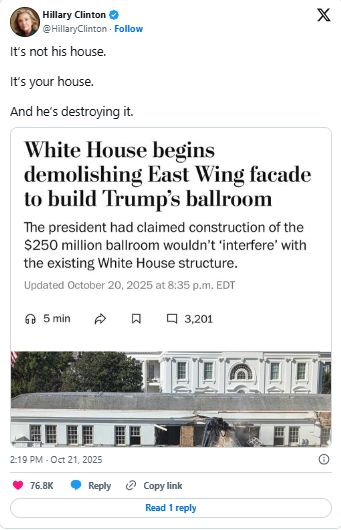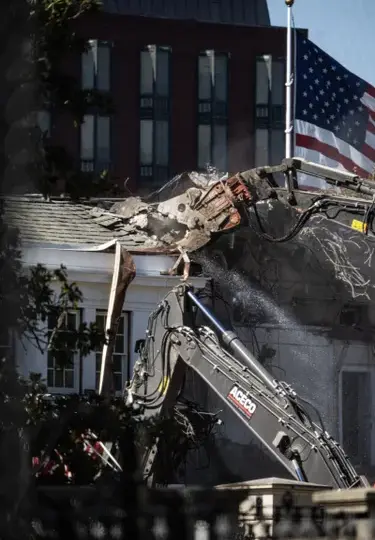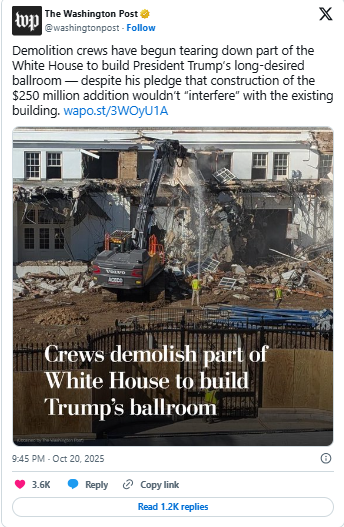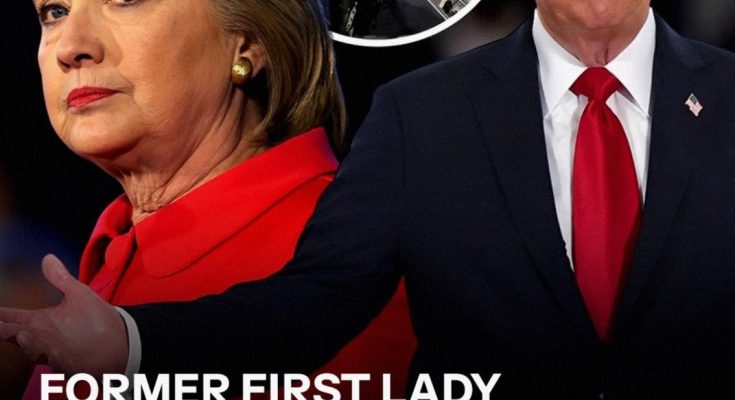A wave of controversy has engulfed Washington, D.C., as demolition crews began tearing down part of the White House’s East Wing to make way for a new presidential ballroom commissioned by President Donald Trump. The project immediately sparked criticism from former First Lady Hillary Clinton, who took to X to sharply rebuke the decision. Clinton reminded Americans that the White House is a national symbol belonging to the public, emphasizing the historic and cultural significance of preserving the estate. She framed the demolition as an alarming disregard for centuries of tradition and a monumental misstep in balancing modernization with historical stewardship.
The $250 million East Wing expansion has quickly become one of the most contentious projects in recent presidential history. Despite earlier assurances from the Trump administration that construction would not interfere with the White House’s historic structure, photographs and eyewitness reports painted a very different picture. Heavy machinery could be seen smashing through parts of the presidential residence’s east side, while the sounds of demolition echoed across the White House campus. Security fencing concealed much of the work from public view, but a handful of onlookers, including Secret Service agents and maintenance personnel near the Treasury Department steps, witnessed the early stages of the controversial project.
President Trump personally addressed the milestone on his social media platform, Truth Social, on October 20, 2025. In a post that quickly drew national attention, he wrote, “I am pleased to announce that ground has been broken on the White House grounds to build the new, big, beautiful White House Ballroom.” He characterized the addition as a “modernization” of the historic estate, claiming that past presidents had long envisioned such a structure but lacked the vision and determination to bring it to fruition. Trump also stressed that the $250 million project was privately funded by “generous Patriots, Great American Companies, and, yours truly,” emphasizing that no taxpayer dollars would be used for the construction. He concluded his post by asserting that the ballroom would serve the nation for generations to come.

While the president praised the expansion as a forward-looking initiative, debate over the project’s implications quickly intensified. For Clinton and other preservation advocates, the issue extends beyond aesthetics or personal preference; it raises fundamental questions about respecting the integrity of one of America’s most iconic buildings. The White House has stood as a symbol of democracy and the people’s sovereignty for more than two centuries, and critics argue that any significant alteration risks undermining that legacy.
The East Wing ballroom controversy was soon overshadowed by another headline involving the president—this time concerning a recent Time Magazine cover story. The magazine had published a flattering article highlighting Trump’s role in brokering a ceasefire in Gaza, but the president took issue with the accompanying photograph. Despite the positive coverage of his diplomacy, he publicly criticized the image for its portrayal of his appearance, claiming on Truth Social that his hair was “disappeared” and that there appeared to be a tiny floating crown above his head. Trump called the photo “super bad” and expressed disbelief over the choice of angle, continuing his long-standing public disputes over media representations of himself.

The media scrutiny came amid another unusual episode: Trump’s brief disappearance from the public eye in late August 2025, which sparked bizarre online speculation about his health and even rumors of his death. He was last seen during a Cabinet meeting, after which the White House released a blank schedule for Labor Day weekend. The absence prompted social media users to speculate wildly, with some claiming he had died, others suggesting it was a clone, and still more mocking his famously branded wardrobe. The president eventually reappeared publicly on August 30, wearing his signature red “Make America Great Again” hat alongside his teenage granddaughter, Kai Trump, and grandson, Spencer Frederick Trump, as they left for a golf club in Sterling, Virginia.

Vice President J.D. Vance publicly addressed the swirling rumors and reassured the public about the president’s health. Speaking to USA TODAY on August 27, Vance described Trump as “incredibly healthy” and full of energy, noting that he maintains an active schedule with early mornings, late nights, and frequent phone calls to stay engaged in governmental matters. While acknowledging the natural concerns surrounding the president’s age, Vance expressed confidence in Trump’s ability to complete his term and deliver on his political promises, emphasizing that any speculation about his well-being was largely unfounded.
As demolition continues at the East Wing and the construction of the new White House ballroom progresses, debate is intensifying over the broader implications of Trump’s actions. Preservationists argue that the historical significance of the White House demands careful stewardship and respect, while the president frames his renovations as visionary and forward-looking. Meanwhile, the ongoing media controversies—from Time Magazine to rumors about his health—highlight the persistent tension between Trump’s personal vision for his legacy and public perceptions of his leadership. Together, these incidents paint a portrait of a presidency marked by bold, unconventional decisions, vigorous self-promotion, and frequent clashes with critics, historians, and the press alike.
A wave of controversy has engulfed Washington, D.C., as demolition crews began tearing down part of the White House’s East Wing to make way for a new presidential ballroom commissioned by President Donald Trump. The project immediately sparked criticism from former First Lady Hillary Clinton, who took to X to sharply rebuke the decision. Clinton reminded Americans that the White House is a national symbol belonging to the public, emphasizing the historic and cultural significance of preserving the estate. She framed the demolition as an alarming disregard for centuries of tradition and a monumental misstep in balancing modernization with historical stewardship.
The $250 million East Wing expansion has quickly become one of the most contentious projects in recent presidential history. Despite earlier assurances from the Trump administration that construction would not interfere with the White House’s historic structure, photographs and eyewitness reports painted a very different picture. Heavy machinery could be seen smashing through parts of the presidential residence’s east side, while the sounds of demolition echoed across the White House campus. Security fencing concealed much of the work from public view, but a handful of onlookers, including Secret Service agents and maintenance personnel near the Treasury Department steps, witnessed the early stages of the controversial project.
President Trump personally addressed the milestone on his social media platform, Truth Social, on October 20, 2025. In a post that quickly drew national attention, he wrote, “I am pleased to announce that ground has been broken on the White House grounds to build the new, big, beautiful White House Ballroom.” He characterized the addition as a “modernization” of the historic estate, claiming that past presidents had long envisioned such a structure but lacked the vision and determination to bring it to fruition. Trump also stressed that the $250 million project was privately funded by “generous Patriots, Great American Companies, and, yours truly,” emphasizing that no taxpayer dollars would be used for the construction. He concluded his post by asserting that the ballroom would serve the nation for generations to come.

While the president praised the expansion as a forward-looking initiative, debate over the project’s implications quickly intensified. For Clinton and other preservation advocates, the issue extends beyond aesthetics or personal preference; it raises fundamental questions about respecting the integrity of one of America’s most iconic buildings. The White House has stood as a symbol of democracy and the people’s sovereignty for more than two centuries, and critics argue that any significant alteration risks undermining that legacy.
The East Wing ballroom controversy was soon overshadowed by another headline involving the president—this time concerning a recent Time Magazine cover story. The magazine had published a flattering article highlighting Trump’s role in brokering a ceasefire in Gaza, but the president took issue with the accompanying photograph. Despite the positive coverage of his diplomacy, he publicly criticized the image for its portrayal of his appearance, claiming on Truth Social that his hair was “disappeared” and that there appeared to be a tiny floating crown above his head. Trump called the photo “super bad” and expressed disbelief over the choice of angle, continuing his long-standing public disputes over media representations of himself.

The media scrutiny came amid another unusual episode: Trump’s brief disappearance from the public eye in late August 2025, which sparked bizarre online speculation about his health and even rumors of his death. He was last seen during a Cabinet meeting, after which the White House released a blank schedule for Labor Day weekend. The absence prompted social media users to speculate wildly, with some claiming he had died, others suggesting it was a clone, and still more mocking his famously branded wardrobe. The president eventually reappeared publicly on August 30, wearing his signature red “Make America Great Again” hat alongside his teenage granddaughter, Kai Trump, and grandson, Spencer Frederick Trump, as they left for a golf club in Sterling, Virginia.

Vice President J.D. Vance publicly addressed the swirling rumors and reassured the public about the president’s health. Speaking to USA TODAY on August 27, Vance described Trump as “incredibly healthy” and full of energy, noting that he maintains an active schedule with early mornings, late nights, and frequent phone calls to stay engaged in governmental matters. While acknowledging the natural concerns surrounding the president’s age, Vance expressed confidence in Trump’s ability to complete his term and deliver on his political promises, emphasizing that any speculation about his well-being was largely unfounded.
As demolition continues at the East Wing and the construction of the new White House ballroom progresses, debate is intensifying over the broader implications of Trump’s actions. Preservationists argue that the historical significance of the White House demands careful stewardship and respect, while the president frames his renovations as visionary and forward-looking. Meanwhile, the ongoing media controversies—from Time Magazine to rumors about his health—highlight the persistent tension between Trump’s personal vision for his legacy and public perceptions of his leadership. Together, these incidents paint a portrait of a presidency marked by bold, unconventional decisions, vigorous self-promotion, and frequent clashes with critics, historians, and the press alike.

